DINOSAURS!!!
I went to Dinosaur Valley State Park in Glen Rose, Texas this weekend. What a fun trip!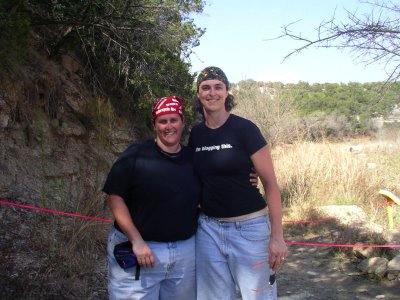
In Glen Rose, we stopped at a restaurant called Grannie's right off the old town square that was owned by a sweet -- well... a grannie-looking woman. She reminded me very much of my beloved, late, great-grandmother ("Grandmaw") in her dress with giant flower-print, matching neck-scarf, and Sunday shoes! She was within an inch of being as tall as i am, which means that for her day and time, she was GI-NORMOUS!!!! The food was delightful, Texas farm-food. If you ever find yourself in Glen Rose, stop off at Grannie's and eat. Yum! Well worth it.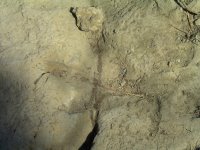 The whole point of the trip was to get out to Dinosaur State Park and see the fossilized dinosaur footprints. I know that looks like "just a shadow" but the shadow in the middle is the footprint. The park was super-cool, and it afforded me the opportunity to take off my boots and wade barefooted in the water, as you can see. It's one of my favorite things to do in warm weather! Here I was searching for the footprints on a shallow ledge in the water. There were some kids on the ledge with me, trying to catch minnows in a butterfly net. They were way more interested in the fish than in the dinosaur footprints!
The whole point of the trip was to get out to Dinosaur State Park and see the fossilized dinosaur footprints. I know that looks like "just a shadow" but the shadow in the middle is the footprint. The park was super-cool, and it afforded me the opportunity to take off my boots and wade barefooted in the water, as you can see. It's one of my favorite things to do in warm weather! Here I was searching for the footprints on a shallow ledge in the water. There were some kids on the ledge with me, trying to catch minnows in a butterfly net. They were way more interested in the fish than in the dinosaur footprints! 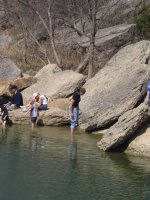 Shortly after that picture was taken, I found a footprint, and turned to holler back at my friends about my discovery. That's when I discovered I was being photographed. In this last picture, I'm standing with one of my feet (my whole giant foot-long foot) inside the smallest toe-imprint of this fossil. All the fossils were three-toed, and some were much bigger than others. If we'd 'done' the park in the reverse order, where we went to the second set of footprints first, and the first set last, i would definitely have been swimming in my undies at the first set.
Shortly after that picture was taken, I found a footprint, and turned to holler back at my friends about my discovery. That's when I discovered I was being photographed. In this last picture, I'm standing with one of my feet (my whole giant foot-long foot) inside the smallest toe-imprint of this fossil. All the fossils were three-toed, and some were much bigger than others. If we'd 'done' the park in the reverse order, where we went to the second set of footprints first, and the first set last, i would definitely have been swimming in my undies at the first set. 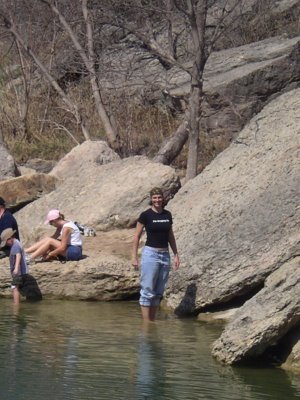 It was a WARM day. As it was, the second location was too busy, too shallow, and too full of chitlins for me to strip down and swim. The first location was perfect, but we hadn't been out in the heat long enough to make me think of swimming. If I ever go back, I'll dress differently and be prepared to take a dip!
It was a WARM day. As it was, the second location was too busy, too shallow, and too full of chitlins for me to strip down and swim. The first location was perfect, but we hadn't been out in the heat long enough to make me think of swimming. If I ever go back, I'll dress differently and be prepared to take a dip! 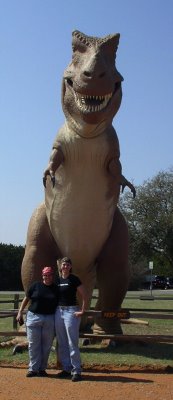 At the entrance to the park, they have two giant fiberglass statues. One is a Tyrannosaurus Rex, the other is a Brontosaurus (now with it's name changed to Apatosaurus!). Those are probably the two most famous and recognizable dinosaurs around, and at the time the park was built they were suspected of leaving the tracks there. More research has shown that those two dinos didn't even live within 50 million years of each other, so they couldn't have laid tracks in the same strata. Brontosaurus (Big Thunder Lizard) has had his name changed to Apatosaurus (Deceptive Lizard) because, apparently, there's a lot of stuff about him that fooled early paleontologists. T. Rex (Tyrant King Lizard) is still the good old, terrifying T. Rex of my childhood. Anyway, they had these fiberglass statues, so they left them up because they're neato-looking and provide a great photo opportunity for the tourists. They now have signs near them stating clearly that these guys did not stomp around the park, but they're mascots so they get to stay. Here I am with my friend and the T. Rex.
At the entrance to the park, they have two giant fiberglass statues. One is a Tyrannosaurus Rex, the other is a Brontosaurus (now with it's name changed to Apatosaurus!). Those are probably the two most famous and recognizable dinosaurs around, and at the time the park was built they were suspected of leaving the tracks there. More research has shown that those two dinos didn't even live within 50 million years of each other, so they couldn't have laid tracks in the same strata. Brontosaurus (Big Thunder Lizard) has had his name changed to Apatosaurus (Deceptive Lizard) because, apparently, there's a lot of stuff about him that fooled early paleontologists. T. Rex (Tyrant King Lizard) is still the good old, terrifying T. Rex of my childhood. Anyway, they had these fiberglass statues, so they left them up because they're neato-looking and provide a great photo opportunity for the tourists. They now have signs near them stating clearly that these guys did not stomp around the park, but they're mascots so they get to stay. Here I am with my friend and the T. Rex.
Because I'm a nerd, I dug around until I found a website that explained which dinosaurs did actually leave tracks at the park. Here's what I found.
What Kinds of Tracks are Found in the Park?
The fossilized tracks in the Paluxy belong to two main types: many are three-toed, sharp-clawed prints made by two-legged meat-eating dinosaurs called theropods. Most of these prints (which are typically 15 to 25 inches long) are thought to have been made by Acrocanthosaurus, a 20-30 foot long carnosaur whose bones have been found in nearby areas. Others tracks in the Paluxy are even larger footprints (some over a yard long) made by huge, four-legged, long-necked plant-eating dinosaurs known as sauropods, or informally, "brontosaurs." The rear prints somewhat resemble giant bear tracks with large claws angling rearward, while the front prints are more round and elephant-like, with less distinct, peg-like toes. Sauropod tracks were unknown to science until discovered in Glen Rose in the 1930's. The most likely trackmaker candidate for the sauropod tracks is a dinosaur named Pleurocoelus, which was 30 to 50 feet long.



No comments:
Post a Comment